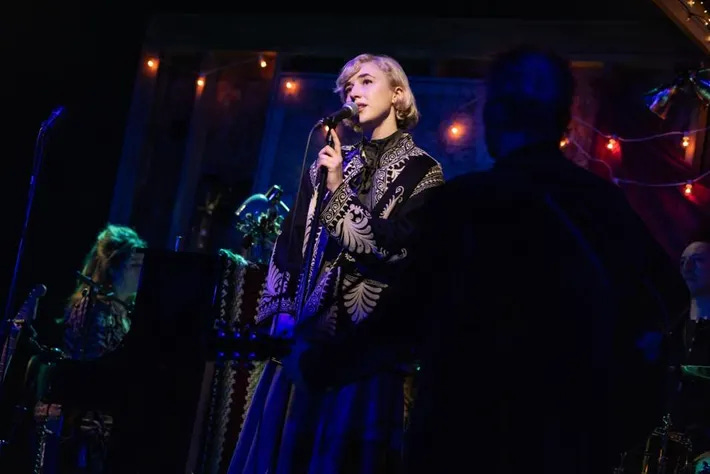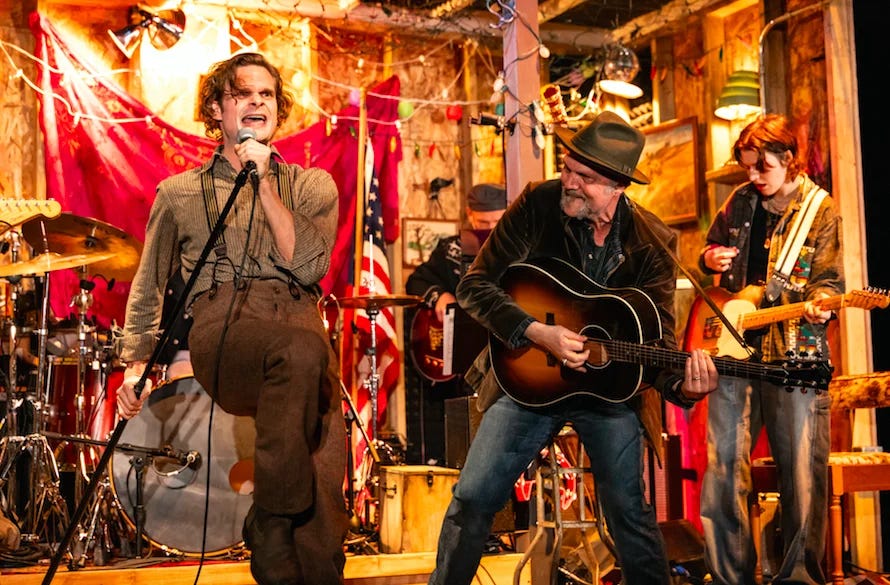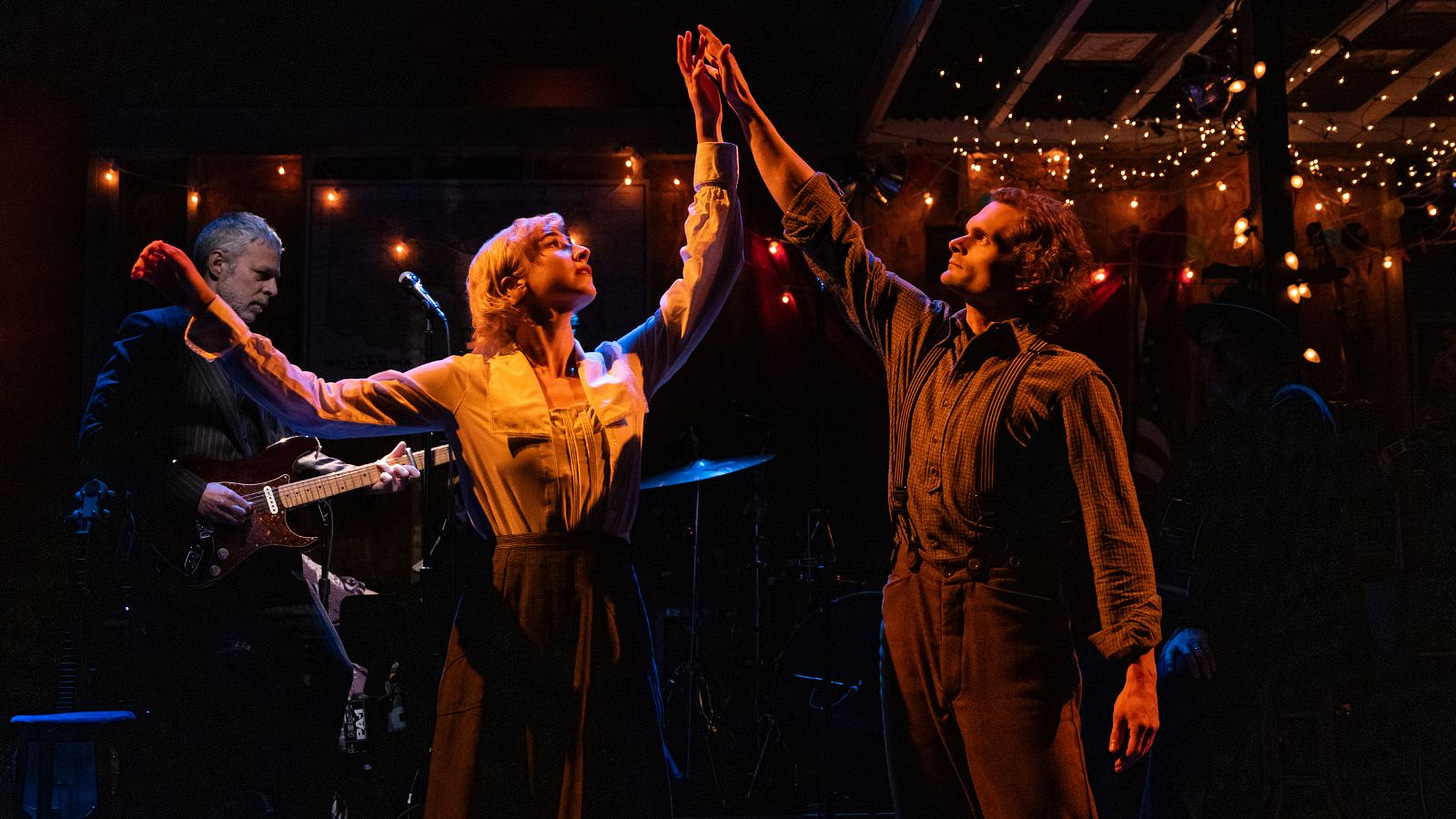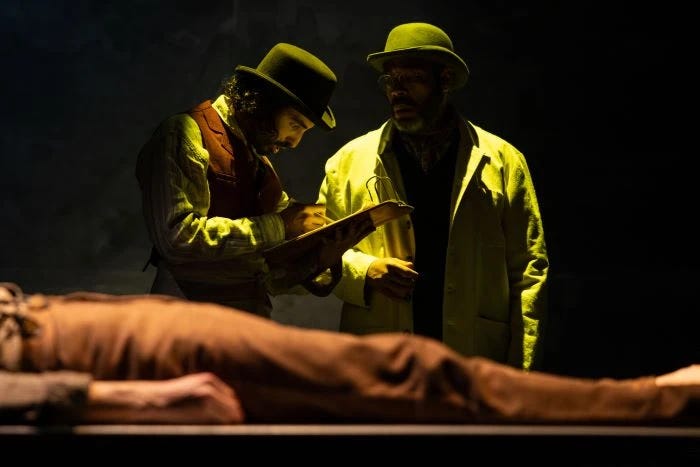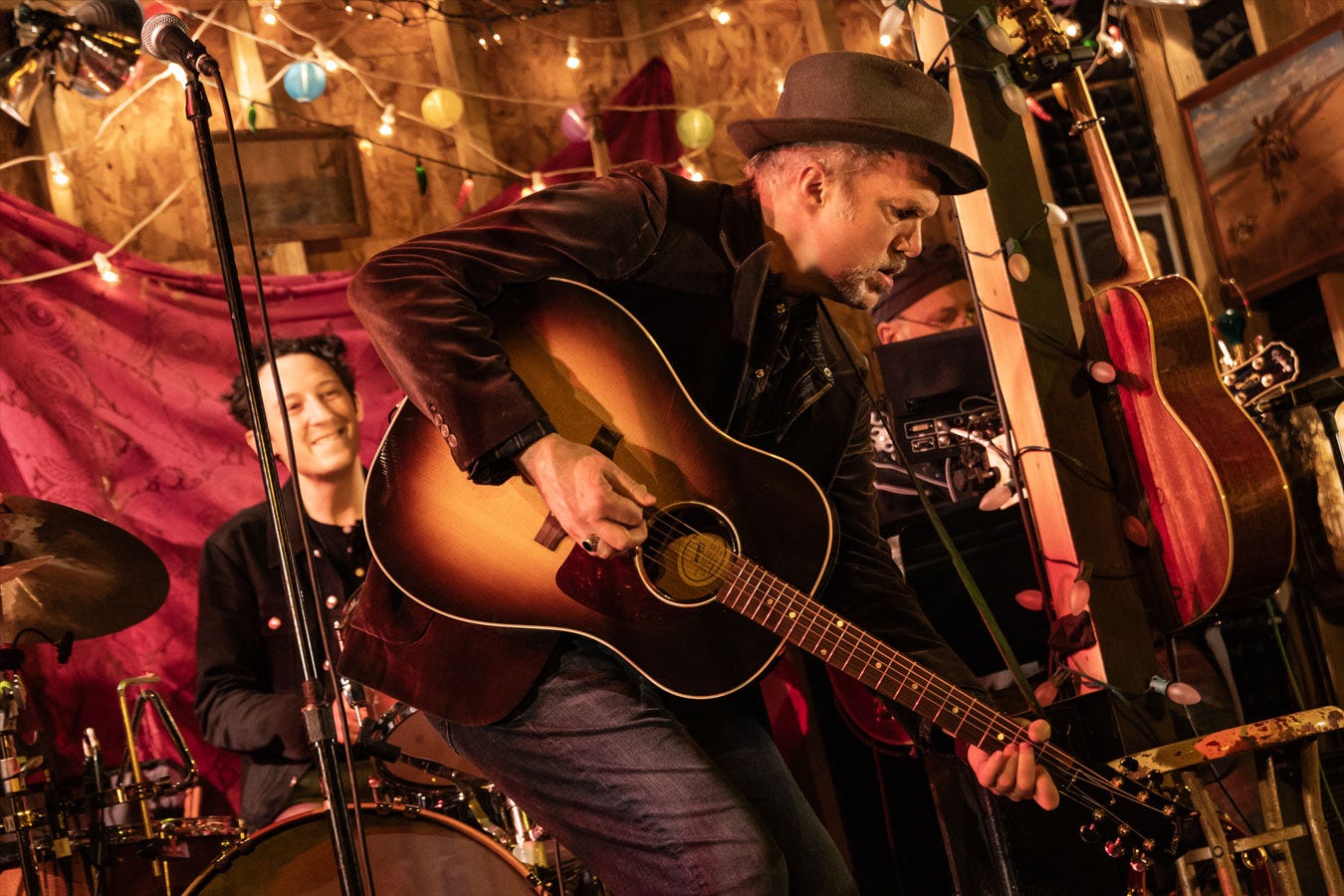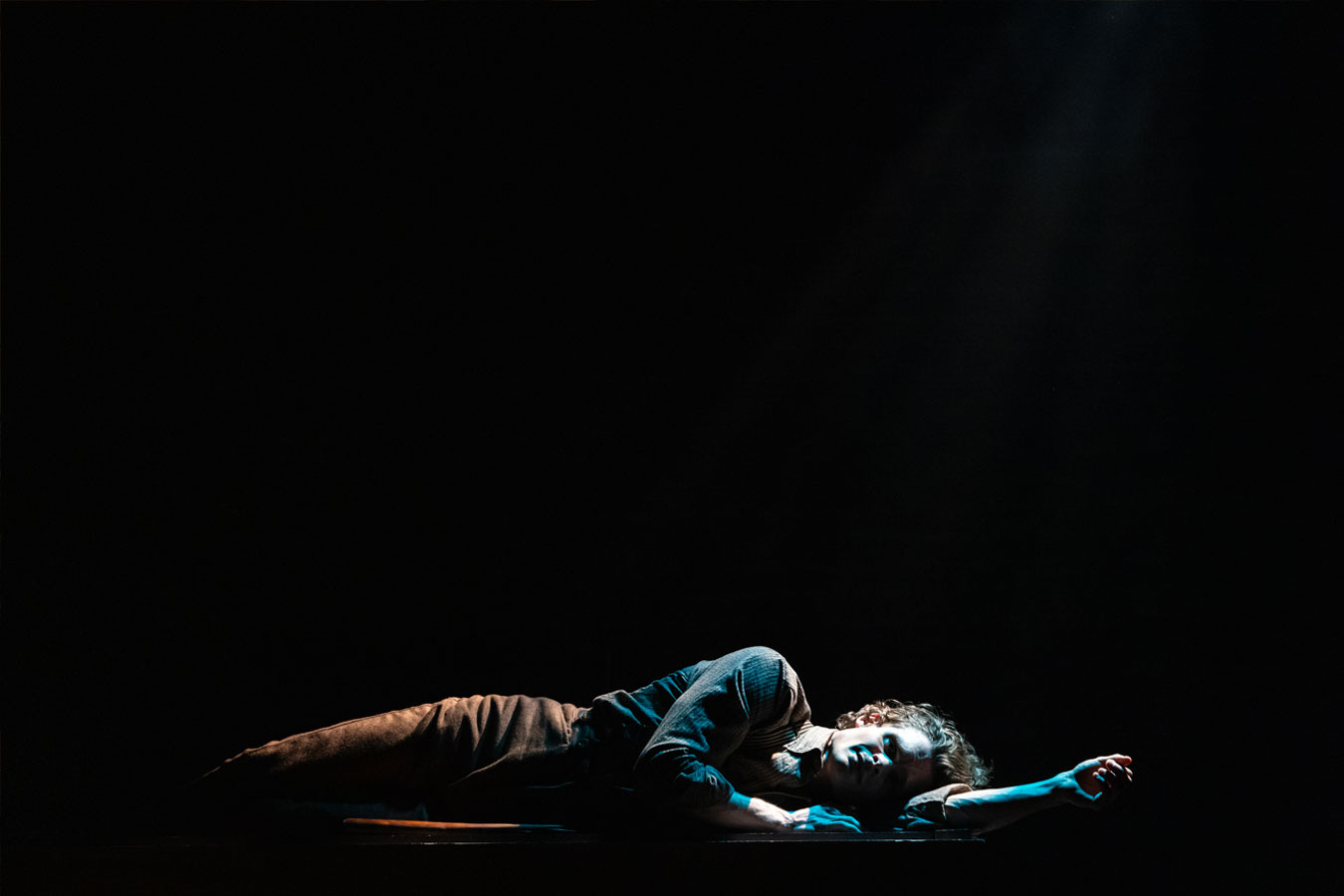A Million Lovely Moments: Dead Outlaw's Lighting Designer Heather Gilbert
Celebrating the many collaborations that led to Dead Outlaw's gorgeous lighting.
There’s a moment in the tremendous off-Broadway show Dead Outlaw where Elmer McCurdy’s ex-girlfriend Maggie walks from where she’s standing stage right to the band set. She steps up to the mike and sings this unexpectedly beautiful, heartfelt song. And this web of lights hanging from the stage left corner of the net quietly come up and paint her in this gorgeous, tender light. It’s of a pitch-perfect piece with actress Julia Knitel’s performance, a transfiguration of the set that allows us to see what’s inside the heart of this young woman who loved Elmer and then discovered he was a total mystery to her.
Throughout the show there are moments like this where a cast member breaks what you might call the internal fourth wall of the stage—even though they’re on stage, the band most often speaks directly to us and is ignored by the characters, as though it exists in our world rather than theirs. But then suddenly—and delightfully—they’ll break that wall and take over, delivering numbers in radically different styles, from that country ballad to a raging punk number that Elmer delivers to a funny Sinatraesque lounge lizard number from the LA coroner who deals with Elmer’s body. (Actually every actor in the show gets a moment like this, another fabulous part of the show.)
And in each case, the lighting, especially of that stage set—which includes so many more kinds of lights than you realize—ends up being a big part of creating that moment: the brightly-lit brashness and severity of the punk moment; the silky darkness and clean controlled light of the lounge.
There’s lots of other wonderful lighting moments in the show that are not related to the band set. One of my favorite is the choice in Elmer’s first childhood scene to have only him seen in the light; we hear his family, but they exist only in the shadows. It’s a brilliant, innovative way of expressing his isolation and disconnection.
Outlaw’s lightning designer Heather Gilbert has done a lot of incredible work, including most recently her Tony-nominated designs for the show Parade. Like Outlaw set designer Arnulfo Maldonado, who I spoke to yesterday, Heather very kindly agreed to answer some questions about Dead Outlaw’s wonderful lighting.
What most excited you about designing the lighting for Dead Outlaw? What were the challenges?
[Director] David [Cromer] invited me to a workshop last September and I flew to NY, knowing little about the show other than Elmer’s incredible story. I sat in that rehearsal hall, hearing the song “DEAD” for the first time, and I was so excited that I would get to light that music that I basically dancing in my seat. This amazing story, this brilliant music. I get to light country and punk and roots and barbershop—it’s a dream come true.
The challenges, like any show, were dealing inside the parameters of space and time. And lighting someone who is moving through the air on a spinning band platform, 8 feet in the air, was a lot of guessing and hoping.
What was your favorite part of the lighting design?
The idea for this design was that it is almost a development of technologies from the rock and roll PAR cans of the ‘70s to the incredibly bright LED moving lights of today, with audience blinders and clip lights and all the Christmas lights and all. It was so fun to use everything that my friend Josh at PRG could help me find. And the way the songs are sometimes band numbers, sometimes book numbers, sometimes the band is singing the thoughts of the characters—it’s all unique and fun to stretch to meet all that Erik [Della Penna] and [David] Yazbek wrote.
Andrew Durand sings Elmer’s raging punk number, the set lights hot and strident.
Were there other projects or designers that were an inspiration for your approach?
Well, I have to say that visually I was most inspired by Sarah Laux, our costume designer, and Arnulfo Maldonado, our scenic designer, which anyone who has seen the show would understand. They are so talented and specific and nuanced. It was very much a dream team for me with them, and with Bella Curry and Josh Millican on sound. I can’t speak highly enough of this team.
I had many meetings with Arnulfo and David in November, and the way the set emerged from both of their brains was glorious to watch.
Julia Knitel and Andrew Durand dance, the little lights around them like fireflies, adding to the magic.
I could go on and on about the choices you made—having Elmer be the only character lit in the early scenes; the movie hall flicker effect; the swath of light on Elmer’s mummified face in the darkness as 20 years pass.
Thank you so much—that movie hall flicker was David’s idea, and we were all actually a bit disappointed when we did it in tech. It had very little impact. Then the audience arrived, we saw it on them and we were mesmerized by how it plays across the people in the theater so gorgeously. I mean, in theory I know that light reveals form and we didn’t have those forms until the audience arrives, but it still blew me away that first preview, seeing it from the back of the house.
So many of these ideas are things that came from David—he tells me an idea—"I want Elmer to be lit just by the table"—then I figure out how all of that can work and what that truly looks like, and then we adjust the idea we talked about once we get in the theater to make it stronger.
As for the sole light on Elmer, the way [actor] Andrew Durand uses that light is nothing short of genius. We have the most talented and kindest cast and band, the face of this gorgeous band of weirdos that made this together.
I absolutely love Eddie Cooper who, among his many roles in this, plays our train conductor. In those scenes he swings a red train lantern that actually belonged to my grandfather who worked for the NY Central Railroad and that our props and electrics departments fitted for the play. It makes my heart sing to watch him with it.
Trent Saunders and Eddie Cooper as the assistant coroner and coroner bathed in a pool of sallow light.
My favorite thing is how the lights on the band set serve to distinguish the different scenes and the moods that go with them. There are clearly a lot more sets and kinds of lights there than you first think—there’s the cluster on the back wall; the net in the corner; the Christmas-like lights that hang along the edge. (Maybe others?) It’s elegant and ingenious. How did you come up with that?
David, Arnulfo, and I looked at a lot of pictures of venues—from people’s basements to places like CBGB. You can see those venues reflected in the shape of the band platform. And we basically grabbed all the variety of lights we could from those images—the DIY-aspect of creating your lighting, although for us the installation was really done with such thoughtful intention by our amazing intention by our electrics team led by Emily Darone.
So Christmas lights and the net of lights, which is an incandescent net with the LED copper wire fairy lights above it. I love how those work together. And yes, there are so many more. Or at least, most of them are controlled individually so that we could be inspired to say “Okay, we love that green light bulb in the standing lamp, let’s only use that for certain songs”; “The colorful lights are in Oklahoma”; “No stars until Iola”; or more basically “That silhouette look is great, let’s add some more clip lights for the back wall to make it bigger.” We have so many options, and you are seeing ideas of both the tools and when we use them from David, Arnulfo, and me.
Lead singer and narrator Jeb Brown jams with his band, the lighting warm and playful.
What are the things you most value in a lighting design?
Strong partnerships, actually. My amazing associates—in this case, the amazing Jackie Fox—sharing the dedication to what the vision of the design is and making it work. I like having people who want to talk about the why’s and how’s. You can make an incredible design with 2 clip lights and a flashlight and a power strip. And I have. But you can’t make strong design without people helping make it happen.
From the director and designers to the electricians installing the show to the stage managers and the crew (I could write a sonnet to our crew, I tell you) and the actors--everyone working together on the same team. That’s what you need to make good design and good theatre.
I think you just did write that sonnet, Heather. Thanks so much for sharing it.
Thanks again to Heather and Arnulfo for sharing their insights, and to all the cast and crew for this brilliant, quirky, lovely show. If you haven’t seen Dead Outlaw yet, it’s in its final weekend. I highly recommend it!




